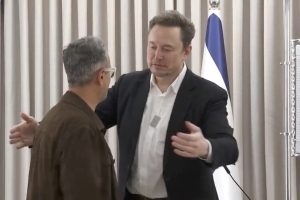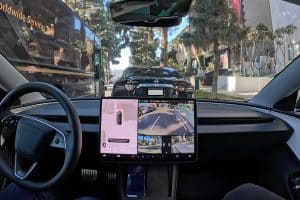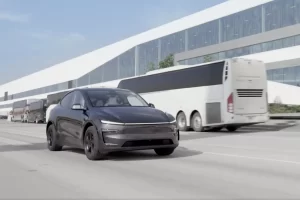- 🚗 Tesla CEO Elon Musk claims the new Roadster will be able to fly.
- 🛰️ Musk suggested SpaceX’s involvement in the Roadster, hinting at aerial capabilities.
- ✈️ Unclear details on how long or how high the Roadster could actually fly.
- 🕒 Production design completion and official unveil expected by the end of this year.
- 🚀 Musk hinted at hovering capabilities for the new Roadster years ago.
- ⚡ Expected to reach 60 mph in under a second, but this is considered the least interesting feature.
- 🛠️ Likely to include steer-by-wire technology, as seen in the Cybertruck.
- 🔄 Possible integration of a modified steering yoke in the performance EV.
Tesla CEO Elon Musk has always been at the forefront of pushing technological boundaries, and his latest assertions about the upcoming Tesla Roadster are no exception. Musk has recently claimed that the new Tesla Roadster will have the ability to fly, hinting that SpaceX, another one of Musk’s ventures, will play a role in making this groundbreaking feature a reality. This blog post delves deep into this exciting development, exploring its feasibility, potential impacts, and what it means for the future of the automotive industry.
Discover the revolutionary claims by Elon Musk about the new Tesla Roadster’s ability to fly, the involvement of SpaceX, and the potential features of this game-changing EV. Learn about production timelines, expected capabilities, and innovations that will redefine the future of transportation.
The Evolution of the Tesla Roadster
Tesla’s Roadster has been one of the most talked-about upcoming vehicles in the EV market. Originally teased a few years ago, it has generated excitement for its incredible acceleration and high-performance capabilities.
Elon Musk’s Bold Claims
Recently, Elon Musk made headlines with his audacious claim that the new Tesla Roadster will be able to fly. While this statement has left many in the industry scratching their heads, it is crucial to understand the context and the technologies that might make such a feat possible.
SpaceX’s Involvement
Musk has hinted that SpaceX might be involved in integrating aerial capabilities into the new Roadster. This collaboration could involve advanced thruster technology used in SpaceX rockets, adapted for automotive use. The hint of SpaceX’s role suggests a merging of automotive and aerospace technologies, pushing the envelope of what is possible in car design.
Feasibility: Can the Roadster Really Fly?
While Musk’s claim is tantalizing, details about the extent and practicality of the Roadster’s flying capabilities remain sparse. Here are a few speculated scenarios:
Hover vs. Flight
- Hovering Capabilities: One plausible feature could be the ability to hover for short distances. This capability was hinted at by Musk years ago, using small thrusters to lift the vehicle a few feet off the ground.
- Short Flights: Another possibility is short-distance flight, aided by thrusters. This could enable the Roadster to navigate over obstacles or rough terrain, providing an unparalleled driving experience.
Expected Features and Timeline
Production and Unveiling
Musk has indicated that the completion of the production design and the official unveiling of the new Tesla Roadster could happen by the end of this year. This timeline suggests that the project is well underway, although Musk’s ambitious timelines have been known to shift.
Speed and Performance
- Incredible Acceleration: One of the standout features of the new Roadster is its acceleration. Musk boasts that the car will reach 60 mph in under a second, a feat that may be facilitated by the same thruster technology mentioned earlier. However, Musk himself mentioned that this might be the least interesting feature of the upcoming EV.
- Steer-by-Wire Technology: Another expected feature is the inclusion of steer-by-wire technology, as seen in the Cybertruck. This advanced steering mechanism replaces traditional mechanical linkages with electronic controls, offering more precise handling and customization options.
Modified Steering Yoke
The new Roadster may also feature a modified steering yoke, borrowing elements from previous Tesla designs but optimized for the performance capabilities of this high-speed EV.
What This Means for the Automotive Industry
If Tesla can successfully integrate flying or hovering capabilities into the Roadster, it would represent a quantum leap in automotive innovation. Here are some potential impacts:
- Revolutionizing Urban Mobility: Vehicles capable of flying short distances could alleviate traffic congestion and provide new solutions for urban transportation challenges.
- Safety and Legislation: The introduction of flying cars will necessitate new safety standards and regulations, which could pave the way for further innovations in vehicle design and infrastructure.
- Market Differentiation: Tesla’s ability to offer such groundbreaking features may further solidify its position as a leader in the EV market, setting new benchmarks for competitors.
Conclusion
Elon Musk’s claim that the new Tesla Roadster will be able to fly is more than just a lofty promise; it symbolizes the relentless pursuit of innovation that defines Tesla and its visionary CEO. As we await the final unveiling of this revolutionary vehicle, the potentials for transforming urban mobility and setting new standards in automotive engineering remain thrillingly high.





